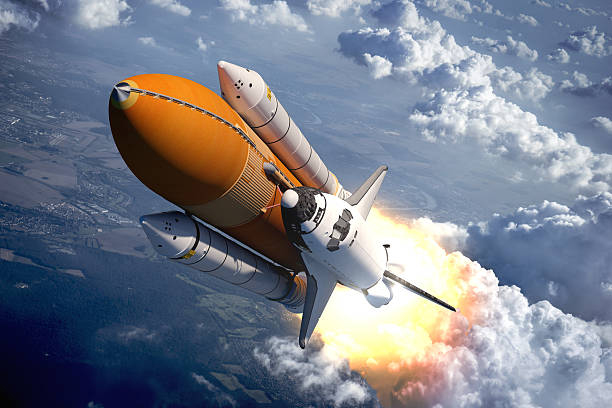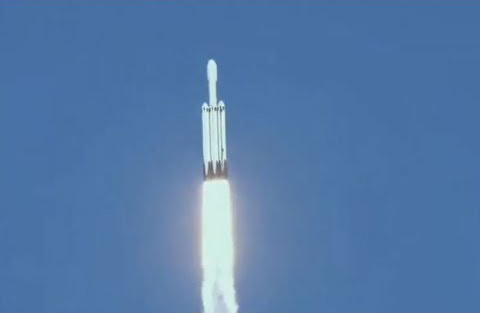= ASTRONAUTICAL EVOLUTION =
Issue 146, 12 April 2019 – 50th Apollo Anniversary Year
| Site home | Chronological index | About AE |
SpaceX Dragon 2 Success
Crew Dragon
Speaking at the press conference following the launch of the Dragon 2 DM-1 flight, NASA Administrator Jim Bridenstine said:
“Tonight was a big night for the United States of America. A great night for NASA. What today really represents is a new era in spaceflight. An era where we are looking forward to being one customer as an agency and as a country… we’re looking forward to being one customer of many customers in a robust commercial marketplace in low Earth orbit. So that we can drive down cost and increase access in ways that historically have not been possible. And we have our first provider of multiple providers today that had a successful launch. This is just the beginning. We’re still in the first quarter; it’s a five-day mission and we’re looking forward to future successes on this mission and missions beyond this one.” (1:19-2:12)
This is official confirmation of what I’ve been saying all along: that the importance of the Commercial Crew programme is not what it does for NASA access to the International Space Station, but rather what it does for broadening access beyond NASA, beyond professional astronauts, to begin to open up the far larger potential market of private space travel.
At 31 minutes on the video space journalist Ken Kramer asks Elon Musk to say more about this aspect. Musk confirms that he expects to fly “private citizens” to the ISS, and that NASA is “very supportive”. He even hints at “something beyond the Space Station” but doesn’t give any more details. (Hardly surprising, when he’s still fully focused on the Dragon 2 mission, which has a number of critical hurdles to jump before it’s home and dry.)
The bigger picture
Here is how I put it a few days ago in a letter to the editor of the German space magazine, Raumfahrt Concret (writing originally in my slightly wonky German). I was responding to a series of articles by well-known space author Eugen Reichl on the emerging NewSpace phenomenon (issues 103-105).
Dear Editor,
It was interesting to read Eugen Reichl describing the growth of New Space. Maybe he was right to say that future historians will regard the year 2018 as a critical “Sputnik moment”. But I would prefer to mention two additional moments of especial significance, each of which will represent a revolution in spaceflight as and when they happen.
Of course it’s satisfying to see new launch vehicles appearing on the scene. But the principal factor restraining our expansion into space remains the extremely high costs of launch to orbit. These costs are attributable to the methods and technologies of spaceflight, which have not yet achieved maturity. Their maturation is in turn held back by the low frequency of launches.
When a robotic satellite is launched, it goes into orbit and sits there and works for one or several decades. People, on the other hand, want to return home, and other people want to take their place. In this way one sees that the critical market for the development of a large-scale space economy is space tourism.
Suppose that at some point in the future a small number of, say, 1,000 people fly every year to space hotels in low Earth orbit and back. For comparison, the present-day market for ocean voyages on cruise ships is 26,000 times greater.
With ten passengers per spacecraft, this scenario has about two launches per week worldwide, so 100 manned space launches per year, instead of the present-day four or five. Under such conditions the technological maturity of the space transport industry must improve rapidly.
As a “Sputnik moment” for space tourism, and hence for the sustainable space economy, I therefore propose the first year in which the number of private visitors to space becomes greater than the number of professional government astronauts. Since at the moment there are only twelve to fifteen official astronauts flying per year, that would seem to be a point that can be reached in the near future – the more so now with the success of the first flight of SpaceX’s Dragon 2 capsule.
One futher point.
In 1985 there were 63 people altogether who flew into space and back on eleven launches: nine of the US Shuttle and two of the Soviet Soyuz. But today such a traffic level seems astonishing, to say nothing of the fact that the number of Shuttle flights was supposed to increase further in the following years, with fifteen launches already scheduled for 1986.
We all know exactly what happened: the Challenger disaster. Never again would as many as nine Shuttles fly in a single calendar year. The planned expansion of manned space transport was put on ice.
The Challenger disaster happened 33 years ago. That means that for a third of a century there has been no progress in manned space transport, and hence no progress towards a traffic level large enough to enable the relevant technologies to finally reach maturity. Manned spaceflight has not yet recovered from the disaster.
So my second “Sputnik moment” is the first year in which the number of all space travellers, including both official astronauts and private space visitors, becomes greater than 63 people.
Both of these events will have the greatest significance for manned spaceflight and hence for the long-term future of humanity.
With best wishes from Oxford.
When?
When might these milestones be reached?
Given the first one – of regular space passenger traffic overtaking the numbers of government astronauts per year – the second should follow within a decade given a reasonable level of growth at, say, 10% per year. But getting the numbers of private passengers up from the one per year of the period 2001-2009 into double figures per year on a regular and sustainable basis is still the big challenge. It needs a step change in the way the entire industry is run. Clearly it would require new permanent accommodation in orbit.
SpaceX’s second great success of this spring – the flawless performance of its first operational Falcon Heavy flight carrying the Arabsat 6A communications satellite and returning all three rocket cores to a safe landing – is immensely encouraging. It points the way to the private space hotels of the future – ventures run by entrepreneurs and visionaries able to circumvent the culture of delay and the dread of achievement which now permeates NASA and the other space agencies around the world.
Might we guess that, with a bit of luck and a lot of hard work, the first milestone could be reached by 2030, and the second by 2040?
Please send in comments by e-mail.
Interesting and relevant comments may be added to this page.
| Site home | Chronological index | About AE |


